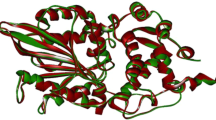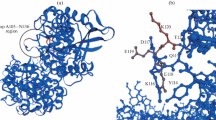Abstract
Phytase efficiently catalyzes the hydrolysis of phytate to phosphate; it can be utilized as an animal supplement to provide animals their nutrient requirements for phosphate and to mitigate environmental pollution caused by unutilized feed phosphate. Owing to animal feed being commonly pelleted at 70 to 90 °C, phytase with a sufficiently high thermal stability is desirable. Based on the crystal structure of PhyA and bioinformatics analysis at variant heat treatments, 12 single and multiple mutants were introduced by site-directed mutagenesis in order to improve phytase thermostability. Mutated constructs were expressed in Pichia pastoris. The manipulated phytases were purified; their biochemical and kinetic investigation revealed that while the thermostability of six mutants was improved, P9 (T314S Q315R V62N) and P12 (S205N S206A T151A T314S Q315R) showed the highest heat stability (P < 0.05) with 24 and 22.6 % greater retention, respectively, compared with the PhyA of the wild type at 80 °C. The K m value of the improved thermostable P9 and P12 mutant enzymes for sodium phytate were 35 and 20 % lower (P < 0.05) with respect to the wild-type enzyme. In conclusion, it is feasible to simultaneously improve the thermostability and the catalytic efficiency of phytase to be used as an animal feed supplement.





Similar content being viewed by others
Notes
Thermostability: thermal stability and the maintenance of the enzyme activity at higher temperatures
References
Viader-Salvado, J. M., et al. (2010). Design of thermostable beta-propeller phytases with activity over a broad range of pHs and their overproduction by Pichia pastoris. Applied and Environmental Microbiology, 76(19), 6423–30.
Lehmann, M., et al. (2000). Exchanging the active site between phytases for altering the functional properties of the enzyme. Protein Science, 9(10), 1866–72.
Kim, T., et al. (2006). Shifting the pH profile of Aspergillus niger PhyA phytase to match the stomach pH enhances its effectiveness as an animal feed additive. Applied and Environmental Microbiology, 72(6), 4397–403.
Abelson, P. H. (1999). A potential phosphate crisis. Science, 283(5410), 2015.
Zhang, W., Mullaney, E. J., & Lei, X. G. (2007). Adopting selected hydrogen bonding and ionic interactions from Aspergillus fumigatus phytase structure improves the thermostability of Aspergillus niger PhyA phytase. Applied and Environmental Microbiology, 73(9), 3069–76.
Mullaney, E. J., Daly, C. B., & Ullah, A. H. (2000). Advances in phytase research. Advances in Applied Microbiology, 47, 157–99.
Lei, X. G., & Stahl, C. H. (2001). Biotechnological development of effective phytases for mineral nutrition and environmental protection. Applied Microbiology and Biotechnology, 57(4), 474–81.
Liao, Y., Li, C. M., Chen, H., Wu, Q., Shan, Z., & Han, X. Y. (2013). Site-directed mutagenesis improves the thermostability and catalytic efficiency of Aspergillus niger N25 phytase mutated by I44E and T252R. Applied Biochemistry and Biotechnology, 171(4), 900–15.
Lehmann, M., et al. (2000). From DNA sequence to improved functionality: using protein sequence comparisons to rapidly design a thermostable consensus phytase. Protein Engineering, 13(1), 49–57.
Zhang, W., & Lei, X. G. (2008). Cumulative improvements of thermostability and pH-activity profile of Aspergillus niger PhyA phytase by site-directed mutagenesis. Applied Microbiology and Biotechnology, 77(5), 1033–40.
Oakley, A. J. (2010). The structure of Aspergillus niger phytase PhyA in complex with a phytate mimetic. Biochemical and Biophysical Research Communications, 397(4), 745–9.
Liu, Q., et al. (2004). Crystallographic snapshots of Aspergillus fumigatus phytase, revealing its enzymatic dynamics. Structure, 12(9), 1575–83.
Xiang, T., et al. (2004). Crystal structure of a heat-resilient phytase from Aspergillus fumigatus, carrying a phosphorylated histidine. Journal of Molecular Biology, 339(2), 437–45.
Ma, Z.-Y., et al. (2011). A novel thermostable phytase from the fungus Aspergillus aculeatus RCEF 4894: gene cloning and expression in Pichia pastoris. World Journal of Microbiology and Biotechnology, 27(3), 679–686.
Rodriguez, E., Mullaney, E. J., & Lei, X. G. (2000). Expression of the Aspergillus fumigatus phytase gene in Pichia pastoris and characterization of the recombinant enzyme. Biochemical and Biophysical Research Communications, 268(2), 373–8.
Hesampour A., O.R.S., M.A. Malboobi, J. Harati, N. Mohandesi (2014) Comparison of biochemical properties of recombinant phytase expression in favourable methylotrophic platforms, Pichia pastoris and Hansenula polymorpha. Progress in Biological Sciences, 4(1):95–109.
Wang, X. Y., Meng, F. G., & Zhou, H. M. (2004). The role of disulfide bonds in the conformational stability and catalytic activity of phytase. Biochemistry and Cell Biology, 82(2), 329–34.
Ullah, A. H. J., et al. (2012). A single mutation in the hepta-peptide active site of Aspergillus niger PhyA phytase leads to myriad biochemical changes. Advances in Microbiology, 2, 388–394.
Liao, Y., Zeng, M., Wu, Z. F., Chen, H., Wang, H. N., Wu, Q., Shan, Z., & Han, X. Y. (2011). Improving phytase enzyme activity in a recombinant phyA mutant phytase from Aspergillus niger N25 by error-prone PCR. Applied Biochemistry and Biotechnology, 166(3), 549–62.
Yao, M.Z., et al. (2012) Phytases: crystal structures, protein engineering and potential biotechnological applications. Journal of Applied Microbiology, 112(1):1–14.
Eswar, N., et al. (2006) Comparative protein structure modeling using Modeller. Current Protocols in Protein Science, chapter 5:unit 5.6.
Gunsteren, van W.F., S. R. Billeter, et al. (1996) Biomolecular simulations: the GROMOS96 manual and user guide. Zürich: VdF Hochschulverlag ETHZ.
Laskowski, R. A., MacArthur, M. W., Moss, D. S., & Thornton, J. M. (1993). PROCHECK: a program to check the stereochemical quality of protein structures. Journal of Applied Crystallography, 26, 283–291.
Kabsch, W., & Sander, C. (1983). Dictionary of protein secondary structure: pattern recognition of hydrogen-bonded and geometrical features. Biopolymers, 22(12), 2577–637.
Pronk, S., et al. (2013) GROMACS 4.5: a high-throughput and highly parallel open source molecular simulation toolkit. Bioinformatics, 29(7):845–54.
Berendsen, H., Grigera, J., & Straatsma, T. (1987). The missing term in effective pair potentials. Journal of Physical Chemistry, 191, 6269–6271.
Gunsteren, van W.F., Billeter S., Eising A., Hünenberger P.H., Krüger P., Mark A.E., Scott W., Tironi I.G (1996) Biomolecular simulation: the GROMOS96 manual and user guide. Zürich: VdF Hochschulverlag ETHZ.
Bussi, G., Donadio, D., & Parrinello, M. (2007). Canonical sampling through velocity rescaling. Journal of Chemical Physics, 126(1), 014101.
Parrinello, M., & Rahman, A. (1981). Polymorphic transitions in single crystals: a new molecular dynamics method. Journal of Applied Physics, 52, 7182–7190.
Darden, T., York, D., & Pedersen, L. (1993). Particle mesh Ewald: an N-log (N) method for Ewald sums in large systems. Journal of Chemical Physics, 98(12), 10089–10092.
Essmann, U., Perera L., Berkowitz M.L., Darden T., Lee H., Pedersen L.G. (1995) A smooth particle mesh Ewald method. Journal of Chemical Physics, 103:8577–8593.
Bekker H., B.H.J.C., Fraaije J.G.E.M (1997) LINCS: a linear constraint solver for molecular simulations. Journal of Computational Chemistry, 18(12):1463–1472.
Oakley, A.J. (2010) The structure of Aspergillus niger phytase PhyA in complex with a phytate mimetic. Biochemical and Biophysical Research Communication, 397(4):745–9.
Zhong-You Ma, S.-C.P., Jing-Jing Jiang, Bo Huang, Mei-Zhen Fan, Zeng-Zhi Li (2011) A novel thermostable phytase from the fungus Aspergillus aculeatus RCEF 4894: gene cloning and expression in Pichia pastoris. World Journal of Microbiology and Biotechnology, 27(3):679–686.
Ben Ali, M., et al. (2006). Thermostability enhancement and change in starch hydrolysis profile of the maltohexaose-forming amylase of Bacillus stearothermophilus US100 strain. Biochemistry Journal, 394(Pt 1), 51–6.
Santarossa, G., et al. (2005). Mutations in the “lid” region affect chain length specificity and thermostability of a Pseudomonas fragi lipase. FEBS Letters, 579(11), 2383–6.
Lehmann, M., et al. (2002). The consensus concept for thermostability engineering of proteins: further proof of concept. Protein Engineering, 15(5), 403–11.
Xiaoying, X., Shaoyang, J., Qimeng, M., & Tao, H. (2014). Heat treatment increases the bioactivity of C-terminally PEGylated staphylokinase. Process Biochemistry, 49, 1092–1096.
Hushan, S. W. G., & Janitha, P. D. W. (2012). Molecular modelling for investigating structure–function relationships of soy glycinin. Trends in Food Science & Technology, 28, 153–167.
Porto, C., Ferrara, M. C., Meli, M., Acampora, E., Avolio, V., & Rosa, M. (2012). Pharmacological enhancement of α-glucosidase by the allosteric chaperone N-acetylcysteine. Molecular Therapy, 20, 2201–2211.
Rakesh, K., Ranvir, S., & Jagdeep, K. (2013). Characterization and molecular modelling of an engineered organic solvent tolerant, thermostable lipase with enhanced enzyme activity. Journal of Molecular Catalysis B: Enzymatic, 97, 243–251.
Acknowledgments
Support for this work by the Shahid Beheshti University and National Institute of Genetic Engineering and Biotechnology is greatly appreciated. We express our deep gratitude to Dr. H. Mollasalehi for his stylistic suggestions in the preparation of the manuscript and his expert editing.
Author information
Authors and Affiliations
Corresponding authors
Rights and permissions
About this article
Cite this article
Hesampour, A., Siadat, S.E.R., Malboobi, M.A. et al. Enhancement of Thermostability and Kinetic Efficiency of Aspergillus niger PhyA Phytase by Site-Directed Mutagenesis. Appl Biochem Biotechnol 175, 2528–2541 (2015). https://doi.org/10.1007/s12010-014-1440-y
Received:
Accepted:
Published:
Issue Date:
DOI: https://doi.org/10.1007/s12010-014-1440-y




